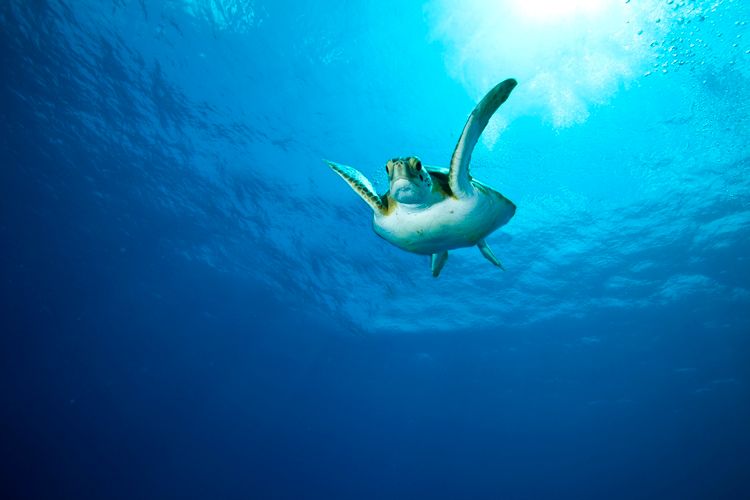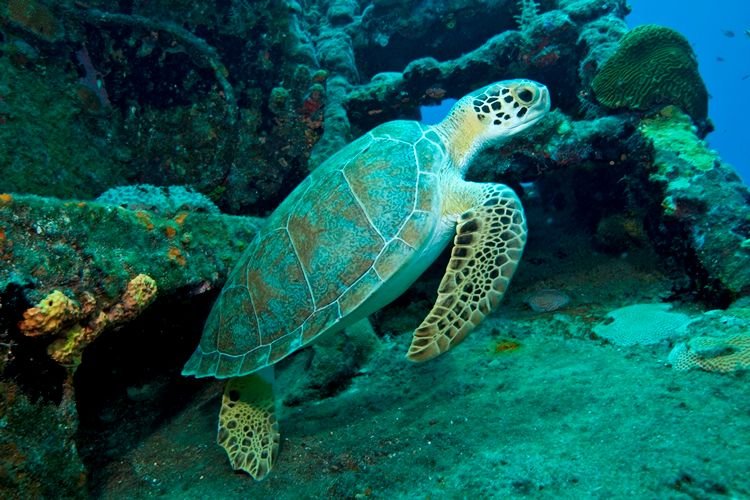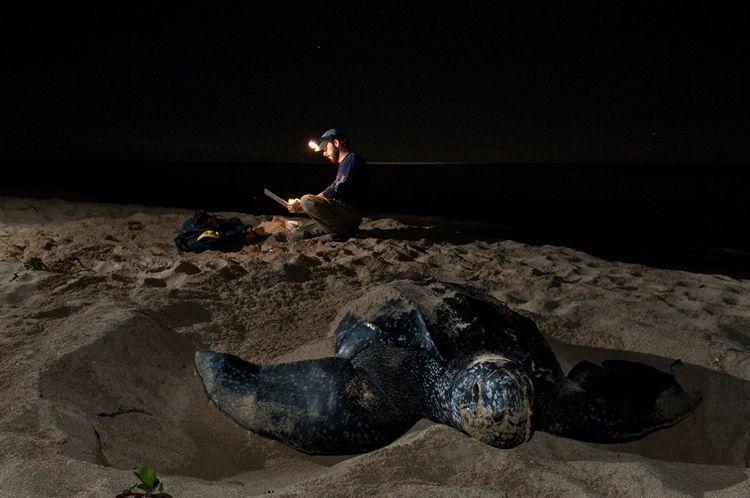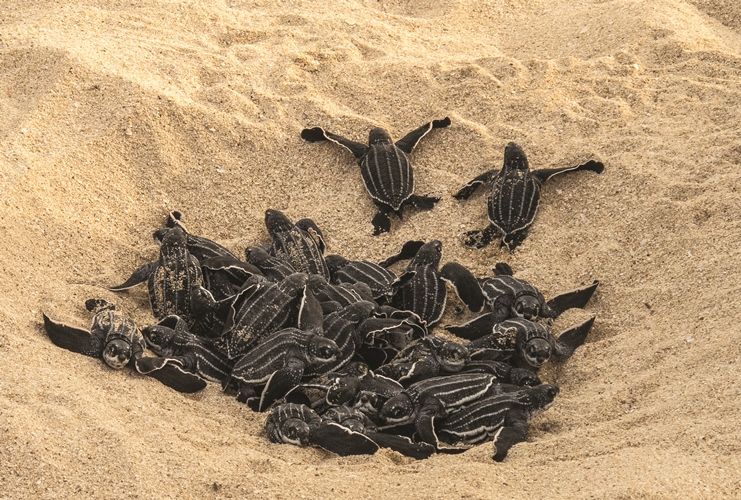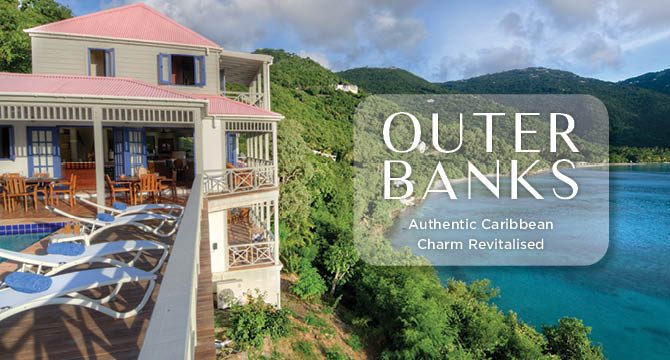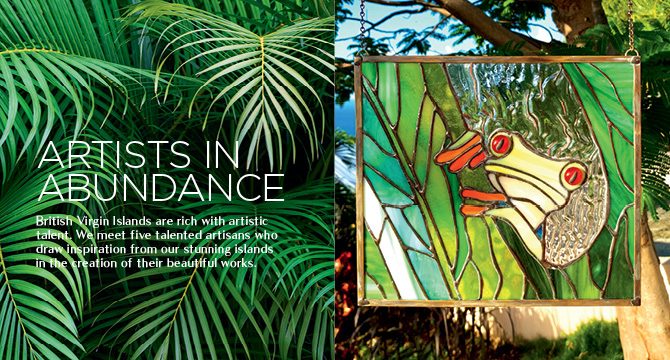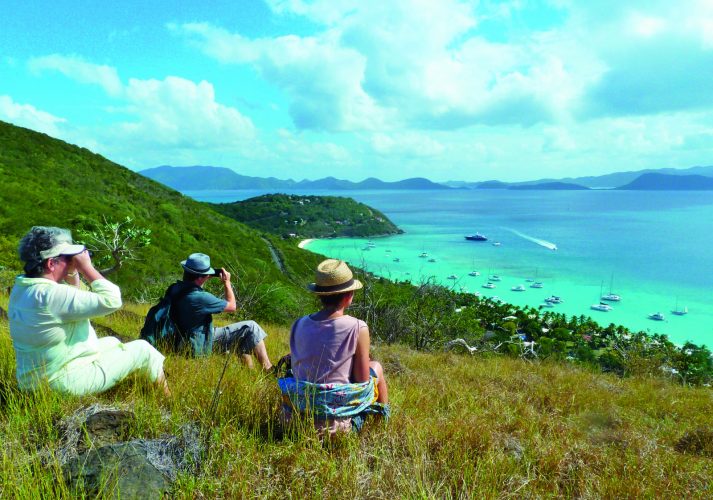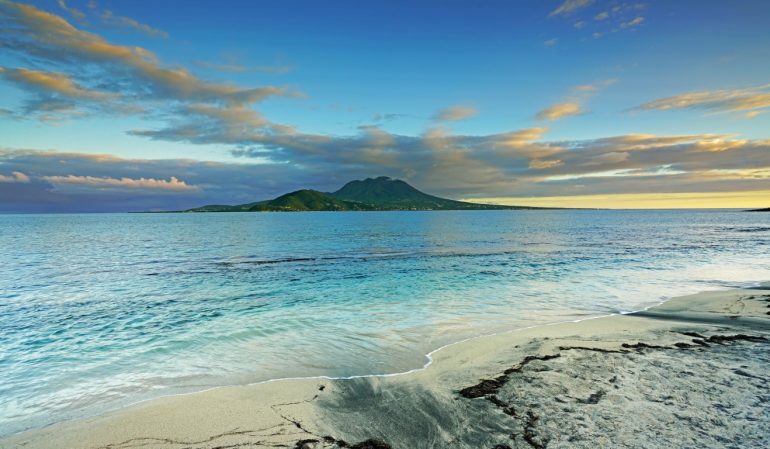Facing The Fate of Dinosaurs – Status of BVI Sea Turtles [mainly leatherbacks]
Words by Paul Porter, Photography by Steve Simonsen & CFD
Dr Shannon Gore, Marine Biologist of Conservation & Fisheries contributed to this article
Imagine you’re a fisherman. Along with your intended catch, your net scoops a creature six foot long, weighing between 500–1500lbs with a brownish-black back and white spots – you’re looking at a leatherback turtle.
They’ve been around longer than dinosaurs, provide some of the best marine-life viewing, and unfortunately, untold numbers die unnecessarily because they get trapped in nets.
Sinkey Boone was a fisherman with a conscience and a deep love for marine life. This attitude combined with his inventor’s mind-set, encouraged him to create a special tool called a Turtle Excluder Device (TED) in the 1970s, that allowed captured sea turtles, like the common green sea turtle (left) and the leatherbacks to escape fisherman’s nets.
Nevertheless, the incredible size of the leatherback—which has been part of its fascinating allure—is also its downfall as they are occasionally too large to fit through the TEDs.
Still, Sinkey had the right idea with regard to protection and conservation of this endangered species and all residents in the BVI have a part to play.
Joel Dore, BVI’s lead team member for leatherback research at the Conservation and Fisheries Department (CFD) relayed some facts and figures in a recent phone interview, that exhibit how important their preservation is: “The BVI protects leatherback turtles and lists them as an endangered species. Killing them…is illegal.”
Dore went on to say that although poaching is not an issue found in the BVI, that’s not the case throughout the Caribbean: “Unfortunately, harvesting for medicinal use…throughout the Caribbean still goes on.”
Dore advised there are only “10-15 adult females right now in the BVI, however, there were 15-25 around 25-30 years ago.” While the main cause of their diminishing numbers is unknown, and impossible to quantify, Dore says trawling is suspect.
Reported activity of leatherbacks nesting is said to be 30–70 times a year, but this takes part every 2–3 years; the CFD have been tagging leatherbacks since 2001, which is how they know they don’t come in annually.
During one season, they can lay as many as 8 nests. Time between nesting is 9 – 12 days, which is why we only have 10–15 individual nesting turtles, one nesting several times a season. They build their nests and deposit their eggs only on tropical and subtropical sandy beaches, and return to birth beaches like other sea turtles.
During nesting season which lasts from March-July, leatherbacks in the BVI lay 50-180 eggs, that hatch 58-62 days after. The hatchlings are about 2 inches long (5cm) and weigh 1.6 ounces (45.8 g). According to CFD’s Dr Shannon Gore, leatherbacks primarily nest on the north shore beaches of Tortola, Beef Island, and Anegada; one nested on Virgin Gorda earlier this year, but may have been a first time nester based on her small size.
Although they nest in the warm climates, adult leatherbacks also easily adapt to cold water. They are known to go as far north as Alaska, Canada, and New England, in water below 40 degrees Fahrenheit–they are the only reptile known to endure such a low temperature. They adapt to cold due to their ample body fat and other physical traits like their insulating layer of subepidermal fat or flippers with counter-current heat exchangers.
Leatherbacks have broad thermal tolerances and adults are known to dive up to 4,922 feet (1,500 meters) in cold water with their unique ability to regulate body temperature. As ancient ocean dwellers inhabiting Earth for 150 million years now, leatherbacks are pelagic and make long migrations with their deep diving capabilities. Their life cycle is predominantly in open water compared to green and hawksbill sea turtles that forage in near-shore coastal waters, hence the reason why we don’t see leatherbacks like we see other species.
Leatherbacks follow jellyfish migrations—being their primary food source—and can be identified by their distinctive rubbery skin on their back instead of a shell. A hydrodynamically shaped body and paddle limbs, make them well-adapted swimmers, but tragically not enough to escape the fishing nets that incidentally gather them along with intended catch like shrimp.
Leatherbacks killed by shrimp catches alone prompted the U.S. in the late 1980s, to require all U.S. trawling shrimp boats to use TEDs; two years later the U.S. expanded that requirement to include non-U.S. shrimp catches intended for U.S. markets.
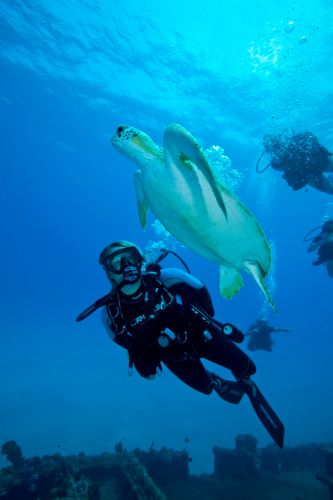
Natural hazards for leatherbacks include predators like ghost crabs, herons, dogs, mongooses, and ants consuming their eggs, but what does the future look like for the BVI dwellers? Are they to face the fate of dinosaurs—who they have outlived—and will we lose this incredible spectacle of BVI marine wildlife?
Dore says the CFD is “hoping that within the next ten years, a non-profit organisation will be created in order to aid them with turtle research.” Dore added, “We need help.”
Leatherbacks have a current worldwide population of between 30,000 and 40,000 and remain on the endangered species list in the BVI, the U.S., and throughout the world. What can residents and visitors of the BVI do?
Most importantly, give leatherbacks their space when they are land-bound. “Those that witness a nesting leatherback need to be respectful of those people tagging and measuring,” said Dr Shannon Gore. “We [the CFD] now have bright red shirts that say ‘sea turtle research team’ on the back.”
People have a tendency to want photos sitting on top of the turtle or will accost the creatures in other ways considered as harassment by the CFD. It is in those moments of excitement and wonder at the rare sight of a leatherback, that people must be humble in the face of this heroic species that has transcended unfathomable time.
